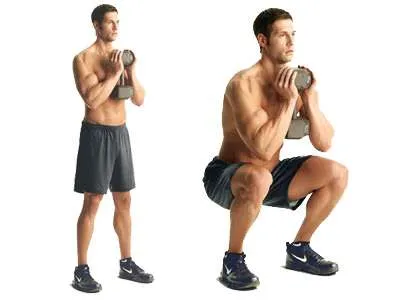Hi Friends of Oompf, it’s Alvan here. Today I will be talking about squats, its benefits and common mistakes one might make while performing a squat.

The squat is a strength exercise that mainly targets your lower body and core. Simple daily activities such as standing up and even sitting down on a chair requires the use of the majority of our lower body muscles. Similarly, the squat also targets the same muscle groups. These are mainly the:
- quadriceps
- hamstrings
- glutes
- abdominals
- calves
- hip flexors
How to perform a squat?
Here are some important cues when performing a basic body weight squat:
1. Stand with feet slightly wider than hip-width apart, with toes slightly turned outward.
2. Tighten and brace your core to stabilize yourself, keep your upper body upright and start to shift your weight back into your heels while pushing your hips behind you as you squat down.
3. Continue to lower yourself until your thighs are almost parallel to the floor. Your feet should remain flat on the ground, and your knees should remain over your second toe.
4. Keep your chest lifted and your feet on the floor, and exhale as you push yourself back up to standing.
Benefits of squats
1. Reduces the risk of injury
Most workout injuries result from weak ligaments, connective tissues and stabiliser muscles (muscles that aren’t directly involved in a movement, but work to keep you steady so that your primary muscles can do their job). Squats help to strengthen these supportive tissues, which can mean the difference between an injury or not. However it is important to keep in mind, technique is paramount when performing any exercise – including squats – in order to avoid injury.
2. Strengthens the muscles of your lower body and core
Squats don’t just help you achieve nice, toned legs; they promote body-wide muscle building. Squats work your quadriceps, hamstrings, calves, abdominal muscles, lower back and your glutes too. Not many exercises allow you to work this many body parts at once.
3. Postural improvements
With improved core strength and leg strength, your posture will also benefit. This is because posture is influenced by muscles in your front and back, which work together. Be sure to combine squatting with stretching and mobilising to achieve the most optimal results.
4. Improve your daily life and physical abilities
Performing squats improve your mobility and balance. It will help you to do your day in and day out activities with ease. Naturally, with all of these improvements, daily tasks such as getting up from a seated position or lifting objects will become easier which is especially important for later in life.
Common Mistakes
Although there are many benefits to squats, performing a squat with poor form overtime could result in adverse effects. Here are some common mistakes that you should look out for when performing your squat.
1. Avoid external and internal rotation of knees
When you allow your knees to cave in or externally rotate, you end up putting increased pressure on your knee joints and ligaments. To avoid this, try to stack your knees directly above your toes as you squat.
2. Lifting onto your toes
The power from standing up from a squat should come from pushing through your heels. So, when you shift more weight to your toes, it causes you to lean forward and your heels will lift off the ground. This results in higher potential for knee injury and overstressed ankles. It will also result in imbalances such as overdominance on the quadriceps and weaker glutes.
3. Neglecting the core
Bracing the core is an important cue to note before performing the squat which many often neglect. Bracing the core helps to stabilize your lumbar spine, keeping your spine in a neutral position as you squat. This will prevent the rounding of hips and spine and avoids placing unnecessary pressure on your back.
4. Forgetting to breathe
Don’t hold your breath. During a squat, it’s critical to breathe into your belly (rather than your chest) to help stabilize your core. Inhale gradually, with control, as you squat. Then, exhale slowly as you press your heels into the ground and rise up. Once you nail your body weight squat, you can always introduce squat variations to add intensity and progression to your regime. Some variations are:
1. Jump squat
2. Barbell squat
3. Goblet squat
4. Overhead squat
Should you squat if you have knee injuries?
This should be first cleared by your physician. A common indicator that you should not squat is if you feel pain. Pain should not be accompanied with this exercise. However if you have previously suffered from this injury and your physician has given you clearance to squat, here are some modifications you can do (fitnessbuilder, 2016):
1 Jumper’s Knee (aka. Patellar Tendinopathy) – Widen your stance about 6-12 inches.
2. Runner’s Knee (aka. IT-Band Syndrome) – Loop a resistance band just under your knees and press out against it while you squat. – Focus on isometrically “spreading the floor apart” with your feet while you squat.
3. Abnormal Tracking (aka. Patellofemoral Syndrome) – Any of the above three modifications. – Stabilize your body more by using the smith machine.
4. ACL Injury (aka. Anterior Cruciate Ligament Injury) – Decrease sheer force by keeping the knee over or behind the ankle.
Did you find this article useful? Email us your feedback at [email protected]
Weighttraining #LesMills #Dumbbell #Highintensityintervaltraining #stationarybicycle #Myfitnesspal #fitnessapp #pullup #personaltrainer

